Updated 2025 — everything parents need to know about gentle, safe baby skincare and grooming in one place.

Introduction
Welcome to Beauty Baby Care — a practical, parent-friendly resource for baby skincare, grooming, and product recommendations in 2025. If you’re a new parent (or supporting one), it can be overwhelming to decide which creams, lotions, shampoos, and other baby care products are actually safe and effective. This pillar guide brings together expert-backed principles, ingredient advice, daily routines, and product categories so you can make confident choices for your little one.
This guide will help you understand:
- How baby skin differs from adult skin and why that matters.
- Which ingredients to look for (and which to avoid).
- Practical daily routines for bath time, moisturizing, and sun care.
- Recommended brands and product categories to start with (plus easy affiliate CTAs).
- FAQs and troubleshooting tips for common skin issues like eczema and diaper rash.
1. How Baby Skin Is Different — The Basics
Baby skin is not simply “smaller adult skin.” It’s biologically different: newborns have a thinner epidermis and an under-developed skin barrier. This makes them more vulnerable to water loss, irritants, allergens, and infections. Because of that, the wrong product — especially something heavy with fragrance, harsh preservatives, or strong detergents — can quickly lead to dryness, redness, or rashes.
In short: baby skin needs gentle, supportive care that prioritizes barrier repair and hydration rather than strong actives better suited for adult skin.
2. The Core Principles of Beauty Baby Care
- Less is more. Use simple formulations with a short ingredient list and proven gentle actives (ceramides, colloidal oatmeal, shea butter).
- Fragrance-free whenever possible. Fragrances are a major cause of irritation and allergic reactions in babies.
- Patch test new products. Always test on a small area (inner forearm) for 48 hours before regular use.
- Hydration + barrier protection. Prioritize moisturizers that lock in moisture and support the skin barrier.
- Talk to your pediatrician for eczema or persistent issues. These conditions often need specific medical guidance.
3. Safe Ingredients vs. Ingredients to Avoid
Below is a quick reference table you can use when reading product labels. Aim for products on the “Safe & Recommended” side and steer clear of items listed under “Avoid These.”
| Safe & Recommended | Why | Avoid These | Why |
|---|---|---|---|
| Ceramides, niacinamide | Support and repair the skin barrier | Parabens, phthalates | Potential endocrine disruptors, avoid for infants |
| Colloidal oatmeal | Soothes irritation, clinically proven | Strong synthetic fragrances | Common irritant and allergen |
| Shea butter, glycerin | Humectants/emollients that lock moisture | SLS / SLES (harsh foaming agents) | Can strip natural oils and dry skin |
| Hypoallergenic formulations | Minimize allergic reactions | Alcohol denat (in high concentrations) | Can be very drying to newborn skin |
Note: “Hypoallergenic” is not a regulated term in many countries, so it’s best used together with ingredient checks and dermatologist recommendations.
4. Daily Baby Skincare Routine — Step by Step
A simple, consistent routine protects your baby’s skin without overloading it with products. Here’s a practical daily pattern that works for most infants:
Bath Time (2–3 times per week for newborns; up to daily for older infants)
- Use a mild, pH-balanced baby shampoo/body wash (fragrance-free).
- Keep bath time short — 5–10 minutes with warm (not hot) water.
- Pat the skin dry with a soft towel; avoid vigorous rubbing.
Moisturizing (Right after the bath)
- Apply a gentle baby lotion or cream while skin is slightly damp to lock in moisture.
- For very dry or eczema-prone skin, use a richer cream or ointment (zinc oxide or petrolatum-based) on affected areas.
Diaper Area Care
- Change diapers frequently and use a barrier cream when redness appears.
- Choose fragrance-free wipes or damp warm cloths.
Sun Protection
- For infants under 6 months, avoid direct sun exposure when possible and use shade/hat.
- For older babies, use mineral-based sunscreen (zinc oxide / titanium dioxide) and protective clothing.
5. Product Categories — What to Buy First
Start with a compact set of gentle essentials rather than a full shelf of products. Here’s a minimal recommended shopping list for parents:
- Gentle body wash / shampoo (fragrance-free)
- Daily moisturizer / lotion with ceramides or colloidal oatmeal
- Barrier cream for diaper rash (zinc oxide based)
- Baby oil or massage oil (pure, minimal ingredients)
- Soft cotton towels and fragrance-free wipes
Each of these categories becomes its own review article on this site — for example: Best Baby Lotions for Sensitive Skin, Best Baby Shampoos, and Best Diaper Rash Creams.
6. Top Brands to Consider in 2025
Here are brands that consistently appear in pediatric and dermatologist recommendations. They vary from drugstore budget options to dermatologist-backed formulas:
- CeraVe Baby — ceramides and barrier support
- Aveeno Baby — colloidal oatmeal, soothing formulas
- Baby Dove — pH balanced, hypoallergenic
- Burt’s Bees Baby — natural-origin ingredients
- Mustela — gentle, designed for newborns
These brands are a good starting point, and you can deep-dive into the best formulas for each category in their respective review posts.
7. Quick Mini-Reviews — Starter Picks (Affiliate CTA Ready)
Below are three starter product picks that are widely recommended for sensitive baby skin. These are short picks you can expand into full reviews later. Swap in your affiliate links where indicated.
CeraVe Baby Moisturizing Lotion
Why parents like it: Contains essential ceramides and niacinamide to strengthen the skin barrier. Fragrance-free and accepted by eczema organizations in many regions.
Best for: Babies with mild to moderate dryness or eczema-prone skin.
Check the latest price on Amazon →
Aveeno Baby Daily Moisture Lotion (Colloidal Oatmeal)
Why parents like it: Colloidal oatmeal soothes red, irritated skin and adds gentle hydration without heaviness.
Best for: Babies with sensitive, easily irritated skin.
Check the latest price on Amazon →
Baby Dove Sensitive Moisture Lotion
Why parents like it: pH-neutral, hypoallergenic formula at an accessible price point.
Best for: Everyday use for babies with normal to sensitive skin.
Check the latest price on Amazon →
Tip: Replace the placeholder links with your Amazon affiliate URLs. Consider adding product images using <img> tags and include alt attributes for accessibility and SEO.
8. Ingredient Deep Dive: Why Ceramides, Oatmeal, and Shea Work
Ceramides: These are lipids naturally found in the skin that keep the barrier intact. In baby products, ceramides help reduce water loss and protect against irritants.
Colloidal Oatmeal: A finely ground oat derivative with anti-inflammatory and soothing properties. Clinically useful for eczema and itch.
Shea Butter & Glycerin: Emollients and humectants that attract and hold moisture, creating a soft, protective layer on the skin.
When a product combines barrier-repair ingredients with minimal irritants (no fragrance, no harsh detergents), it becomes a reliable daily option for sensitive baby skin.
9. Common Skin Issues & What To Do
Eczema (Atopic Dermatitis)
Symptoms: dry, itchy, red patches. Treatment tips: consult your pediatrician, use gentle ceramide creams, and avoid known irritants. Prescription treatments may be necessary for moderate to severe cases.
Diaper Rash
Symptoms: redness in the diaper area. Tips: frequent diaper changes, air time, barrier creams with zinc oxide, and fragrance-free wipes.
Heat Rash
Symptoms: small red bumps in skin folds. Tips: keep baby cool and dry, dress in breathable fabrics, and avoid heavy creams in affected areas until rash improves.
10. Shopping & Safety Tips (Quick Checklist)
- Read full ingredient lists — don’t rely on marketing buzzwords.
- Choose fragrance-free or naturally-scented products with caution.
- Avoid using multiple new products at once so you can identify irritants.
- Keep products out of reach of children and store in a cool, dry place.
- When in doubt, consult your pediatrician or a pediatric dermatologist.
11. Frequently Asked Questions (FAQ)
How often should I moisturize my baby?
For most babies, moisturizing once daily after a bath is enough. For dry or eczema-prone skin, apply twice a day or as recommended by your pediatrician.Can I use adult skincare products on my baby?
No — adult products often contain stronger actives, fragrances, and preservatives unsuitable for infant skin. Stick to baby-formulated or dermatologist-recommended gentle options.Is “natural” always better?
Not necessarily. Natural ingredients can still be allergenic (e.g., nut oils, essential oils). The key is a short, gentle ingredient list and clinical testing (dermatologist-tested, hypoallergenic labels).When should I see a pediatrician for a skin issue?
If you notice widespread redness, oozing, fever, or symptoms not improving after a few days of home care, contact your pediatrician. For persistent eczema, get a medical plan to avoid scarring and infection.
Top 3 Starter Baby Care Picks
| Product | Key Features | Rating | Buy Now |
|---|---|---|---|
CeraVe Baby Moisturizing Lotion | Contains ceramides and niacinamide to restore the skin barrier. Fragrance-free, dermatologist-tested, accepted by the National Eczema Association. | ⭐ 4.7/5 | Check on Amazon → |
Baby Dove Sensitive Care Lotion | Hypoallergenic and pH-neutral formula. Keeps skin soft for 24 hours and is free from parabens, phthalates, and dyes. | ⭐ 4.7/5 | Check on Amazon → |
Johnson’s Naturally Sensitive Aloe & Shea Lotion | Gentle classic formula with aloe vera and shea butter. Light texture absorbs fast; dermatologist-tested and pediatrician-approved. | ⭐ 4.3/5 | Check on Amazon → |
Disclaimer: Prices and ratings are accurate as of posting and may change. As an Amazon Associate, I earn from qualifying purchases.

Conclusion — Keep It Simple, Stay Observant
Beauty baby care is about gentle, consistent protection and smart ingredient choices. Start with a short list of essentials, choose products with barrier-supporting ingredients, and monitor how your baby responds. When you build your site around quality pillar content like this and interlink to specific, conversion-focused product reviews, you’ll help both parents and your affiliate performance.
If you’re ready to dive deeper, check our category reviews: Best Baby Lotions, Best Baby Shampoos, and Best Diaper Rash Creams.
Disclaimer: This page contains affiliate links. As an Amazon Associate, we earn from qualifying purchases. Consult a pediatrician for personalized medical advice.
— Beauty Baby Care team